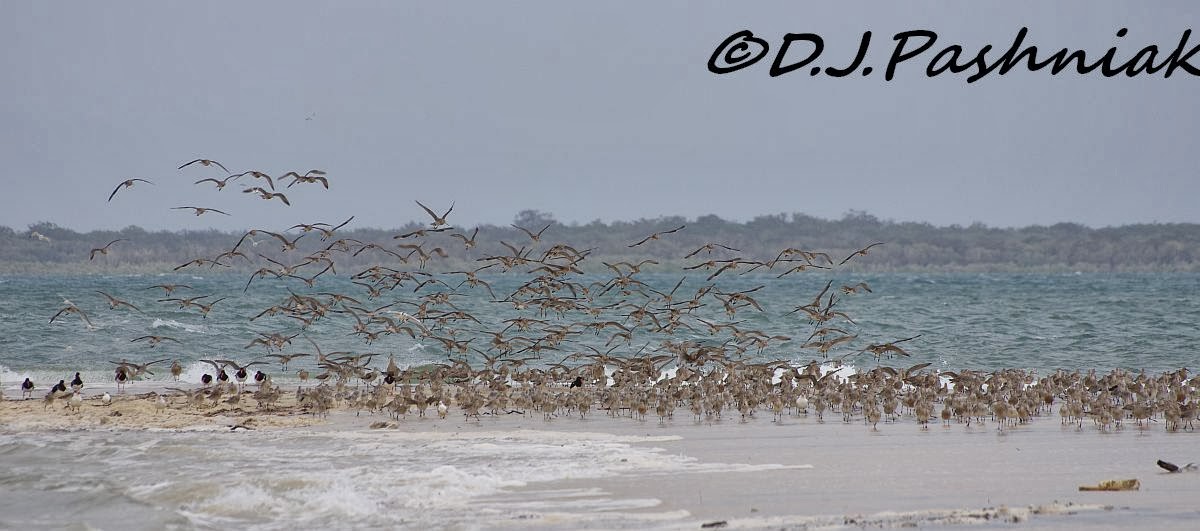Here is the retrospective! When I moved up here I knew very little about shorebirds. I bought a kayak and started seeing groups of shorebirds roosting in various places. Simple curiosity made me want to identify what I was seeing. (And that is another long story!) Then I learned that shorebirds (with a few exceptions!) are site specific and also that their numbers are decreasing every year. I wanted to find out if this was the same for the birds and the roost sites I was observing around here. So here is what happened.
This is where I first started kayaking and is taken from the Mullens picnic area looking out towards the roost site that we now call the Airport Roost.
This photo is looking back towards the picnic area from the roost area.
And this photo is a small plane coming in to land on the nearby air strip and shows why we have named this roost site the Airport Roost.
The first shorebirds that I saw were Grey-tailed Tattlers and Terek Sandpipers in an old dead mangrove tree right next to the channel of the creek used by all the boats from the Mullens picnic area. This photo was taken in April of 2006 with my first digital camera - a 3 MP Kodak.
I found that these two kinds of shorebirds were usually at this roost site and I have not seen Terek Sandpipers anywhere else in all the area south of Inskip Point. So the rest of this post is a pictorial record of these two species on this site up to the present. (Of course there are other kinds of shorebirds also using this roost but I am writing a post not a book!)
This photo was taken of the birds in the same tree but with my next camera - a Canon S2 with a 12 times zoom and an extender as well. I could now see enough details to be sure of my ID. The photo was taken in November of 2006. Shorebirds had completed a migration to the north and a breeding season up there then another migration south. (All these photos need to be clicked on to enlarge to make the details of the birds more visible. )
By March of 2007 - the end of that same summer - the tree right in the channel had fallen down and the birds were now making use of a tree at the end of the creek and just around into the bay.
During the next summer season (December 2007) I saw more of these birds than I had ever seen before and they were all standing on the sand in a large group which also included a number of Bar-tailed Godwits and even an Eastern Curlew. (To get photos I tied the kayak behind some mangroves and shuffled along on my knees in the water using the trees to hide me from the birds until I got close enough to look through the branches and take my photos!)
Exactly a year later (December 2008) they were again roosting in one of the mangrove trees. (From this time on I have been using a Pentax K200 and a Pentax K5 with a zoom lens of 70-300. I have a longer zoom lens but it is just too heavy for me to manage on the kayak!)
I have no photos for the next couple of years. On memory I still saw some birds at the site but did not manage any photos before they flew off so have no idea of their numbers or if both kinds of birds were still there. The next photo was taken in November 2010 and the birds were roosting on mangrove roots on a not so high tide.
The next photo showing both kinds of birds is September 2011 and a few were roosting along the sand. I have a similar photo taken a little later in the season.
I have no photos showing both kinds of birds until just this month when I photographed Terek Sandpipers in the roost tree just after the Tattlers had flown off. I know the Tattlers have been there all this time and I have taken a number of photos of them by themselves both right on this roost site and also a little further away where there are other mangrove trees where they sometimes roost.
All these photos show that this roost site has been used over a period of the last 8 years. The birds prefer to roost in the large Grey Mangrove trees with open branches where their view out is not restricted by small branches and leaves. The count data I have recorded shows that numbers are now less than half of what we first counted. However, the population of the town has increased over the same period and there are more housing developments being planned. Possibly some signage right on this site might help and also some more specific publicity.


































